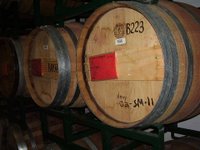Friday Stefania and I drove up to San Francisco to taste our 2005 barrels.
It was a trip I was a little worried about. I have not been happy with the 05 Cabernet. It’s been a nice wine, easy to drink and I think would fall into the 82-84 point range. Not bad, but as Stefania has said “It’s a $10 wine.”
I couldn’t really afford to bottle and release a $10 bottle of wine, my production costs are in the $18 a bottle range. So, this was a make or break for the Cabernet. If it had not shown improvement, I was likely going to sell it on the ‘bulk’ wine market. I don’t want to release just ‘nice’ wines, I want them to be better than that.

(searching for our barrels)

(giving Dave topping instructions)
So we started the tasting with Dave Gifford who always guides us through the barrel room and takes down my instructions.
We started with the 2005 Eaglepoint Ranch Syrah. The wine had just been sulfured so we were expecting some reduction notes. Wow. This wine is turning out great. Some of the rustic edges from 3 months ago are smoothing out. It’s a dark, rich, layered wine. Lot’s of complex black fruit flavors and notes of black pepper. The 25% new oak adds some really nice sweet spice flavors without showing obvious oak. This was just what I’m after. It’s not a little Syrah, and I think it will be best after 3-5 years in bottle. I was very happy with this and I think people will really enjoy this wine.

(Finding the Syrah, pipe in hand)

(Zebra barrel, 50% new oak)
Then off we went to the Cabernet barrels. Stefania knew I was worried about these barrels so it was hushed as we tasted.
The first thing that surprised us was the change in color. This wine has gotten much-much darker in the past 3 months. It’s now a deep red. A dramatic change from the light red of June. The nose was much more pronounced. A green spice/currant note that is typical of young Cabernet, then lots of red juicy fruit. It also had nice notes of anise and cinnamon and much better length and depth. The 50% new oak had added a lot of backbone to the wine.

(The red labels mean we sourced these grapes ourselves, they are not ‘Crushpad grapes’)

(tasting the Cab, notice the color!)
We then did a quick blend of about 5% Syrah with the Cabernet. That was the magic combo. The Cab got darker still with black fruit.
I left Dave with instructions to rack the Syrah. I want to avoid any reductive notes from getting in. I also told him to start topping off the Cab barrels with the Syrah. This should bring it up to about 3-4% Syrah at bottling, and and the color and black fruit the wine is short of now.
We then headed South to Bistro Elan in Palo Alto with some samples to share with friends and get some non-biased opinions from the wine manager there. The Syrah showed well, and the kitchen staff polished off the bottle! We showed the Cab last, waiting for feedback on our problem child. The verdict: “It’s a nice cab. Not too heavy, and with good red fruit. It needs a bit more color and some length and breadth of fruit, 88 points.”

(tasting with food at Bistro Elan in Palo Alto)
I went home happy and finally not worrying about what to do with the Cabernet. 10 more months in barrel and the 3-4 % Syrah should add what it’s short on right now, and lift that 88 points to the 90+ range I’m after. I was feeling much better, that in a year the Cabernet will be drunk as quickly as the Syrah was that night.
Cheers,
Paul





















